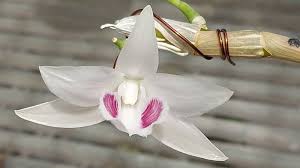# The Applications of Technology in Dendrobium Orchid Cultivation

Dendrobium orchids, particularly *Dendrobium nobile*, are cherished for their stunning beauty and unique growing habits. With the rise of technology in horticulture, orchid cultivation has evolved dramatically, making it easier and more efficient for both hobbyists and professional growers. This article explores various technological applications that enhance the cultivation of Dendrobium orchids, from precision agriculture to smart greenhouse systems, and how these innovations improve plant health, productivity, and sustainability.
## 1. Precision Agriculture in Orchid Cultivation
### 1.1 Definition and Importance
Precision agriculture refers to the use of technology to monitor and manage field variability in crops. In orchid cultivation, precision agriculture allows growers to optimize resources, improve plant health, and increase yields. Key aspects include soil management, nutrient application, and irrigation control.
### 1.2 Soil Sensors
Soil sensors play a crucial role in precision agriculture by providing real-time data on soil moisture, temperature, and nutrient levels. This information enables growers to make informed decisions regarding watering and fertilization.
– **Moisture Sensors**: These devices measure the water content in the soil, helping growers determine the optimal time for irrigation. For Dendrobium orchids, maintaining the right moisture levels is vital for healthy growth and flowering.
– **Nutrient Sensors**: These sensors analyze the soil composition, allowing growers to assess nutrient deficiencies and adjust fertilization practices accordingly.
### 1.3 Automated Irrigation Systems
Automated irrigation systems utilize data from soil sensors to deliver precise amounts of water to plants. This not only conserves water but also ensures that Dendrobium orchids receive the right amount of moisture at the right time. Key technologies include:
– **Drip Irrigation**: This system delivers water directly to the root zone, minimizing evaporation and runoff. It is especially beneficial for orchids, which thrive in well-drained environments.
– **Smart Controllers**: These devices can be programmed to adjust irrigation schedules based on weather forecasts and soil moisture levels, ensuring optimal watering conditions.
## 2. Climate Control Technologies
### 2.1 Greenhouse Automation
Greenhouses equipped with automation technology allow for precise control of environmental conditions such as temperature, humidity, and light. This is particularly important for Dendrobium orchids, which require specific conditions for optimal growth.
– **Environmental Sensors**: Sensors monitor temperature, humidity, and light levels within the greenhouse. Data from these sensors can trigger automated systems to adjust conditions as needed.
– **Automated Ventilation Systems**: These systems can open or close vents based on temperature and humidity readings, maintaining a stable environment for orchids.
### 2.2 LED Grow Lights
Light is a critical factor in orchid cultivation, influencing growth and flowering. LED grow lights offer several advantages over traditional lighting systems:
– **Energy Efficiency**: LEDs consume less electricity and produce less heat, making them a cost-effective option for long-term use in greenhouses.
– **Full Spectrum Lighting**: Advanced LED systems can provide a full spectrum of light, allowing growers to customize light conditions based on the specific needs of Dendrobium orchids at different growth stages.
### 2.3 Climate Monitoring Apps
Many growers are now using smartphone apps to monitor and control greenhouse conditions remotely. These applications allow users to track temperature, humidity, and light levels, and even control irrigation systems from their mobile devices. This flexibility enables growers to respond quickly to changes in environmental conditions, ensuring the health of their orchids.
## 3. Nutritional Management Technologies
### 3.1 Fertilizer Management Systems
Proper nutrition is vital for the healthy growth of Dendrobium orchids. Advanced fertilization technologies enable precise nutrient management, promoting optimal growth and flowering.
– **Smart Fertilizers**: These fertilizers are designed to release nutrients slowly over time, ensuring that orchids receive a steady supply without the risk of over-fertilization.
– **Fertilizer Injection Systems**: Automated systems can inject the appropriate amount of fertilizer into the irrigation water, allowing for precise nutrient delivery tailored to the specific needs of the plants.
### 3.2 Nutrient Monitoring Devices
Nutrient monitoring devices provide real-time feedback on the nutrient levels in the growing medium. This technology enables growers to adjust their fertilization strategies based on actual plant needs.
– **EC and pH Meters**: Measuring electrical conductivity (EC) and pH levels helps growers determine the nutrient availability in the growing medium, allowing for timely adjustments to the fertilization program.
## 4. Pest and Disease Management
### 4.1 Integrated Pest Management (IPM)
IPM is an environmentally sensitive approach that combines biological, cultural, and chemical practices to manage pests and diseases. Technology plays a significant role in implementing effective IPM strategies.
– **Pest Monitoring Systems**: Smart traps equipped with sensors can monitor pest populations and send alerts to growers. This allows for timely intervention before infestations occur.
– **Remote Surveillance**: Cameras and drones can be used to monitor large growing areas for signs of pest damage, enabling quick responses to potential threats.
### 4.2 Disease Detection Technologies
Early detection of diseases is crucial in preventing the spread and minimizing damage. Several technological advancements aid in disease management for Dendrobium orchids.
– **Digital Imaging and Analysis**: High-resolution cameras and image analysis software can identify signs of disease or stress in plants. By analyzing leaf patterns and colors, growers can detect issues early and take appropriate action.
– **Mobile Apps for Disease Identification**: Various apps are available that allow growers to photograph affected plants and receive instant feedback on potential diseases, along with recommended treatments.
## 5. Propagation Technologies
### 5.1 Tissue Culture Techniques
Tissue culture is a widely used method for propagating orchids, including Dendrobium species. This technique allows for the mass production of genetically identical plants, ensuring consistency in quality and traits.
– **In Vitro Cultivation**: In this sterile environment, plant tissues are cultured in nutrient-rich media, enabling rapid growth and development. Tissue culture reduces the risk of diseases that can affect conventional propagation methods.
– **Cryopreservation**: This advanced technique involves freezing plant tissues to preserve genetic material. It allows for the long-term storage of rare or valuable orchid varieties for future use.
### 5.2 Biotechnological Innovations
Biotechnology is revolutionizing the way orchids are propagated and bred. Some innovations include:
– **Genetic Engineering**: Scientists are exploring genetic modifications to enhance traits such as disease resistance, flower longevity, and color variations in Dendrobium orchids.
– **Molecular Markers**: These markers help in selecting parent plants with desirable traits for breeding programs, speeding up the process of developing new orchid varieties.
## 6. Data Analytics and Artificial Intelligence
### 6.1 Utilizing Data for Improved Outcomes
Data analytics is increasingly being utilized in orchid cultivation to make informed decisions based on historical data and real-time monitoring.
– **Yield Prediction Models**: By analyzing past data on growth rates, environmental conditions, and care practices, growers can predict yields more accurately and adjust their cultivation strategies accordingly.
– **Performance Tracking**: Data analytics can help track the performance of different orchid varieties under specific conditions, allowing growers to refine their practices and improve outcomes.
### 6.2 Artificial Intelligence Applications
Artificial intelligence (AI) is finding its way into horticulture, providing innovative solutions for orchid growers.
– **Smart Assistants**: AI-powered assistants can help growers by providing real-time recommendations on care practices based on current conditions and historical data.
– **Automated Decision-Making**: AI systems can analyze data from various sources (sensors, weather forecasts, etc.) to make decisions about irrigation, fertilization, and pest management, enhancing efficiency and plant health.
## 7. Online Communities and Resources
### 7.1 Virtual Learning Platforms
The rise of online education platforms has made it easier for orchid enthusiasts and growers to access valuable resources and learn about Dendrobium cultivation.
– **Webinars and Online Courses**: Many organizations and experts offer webinars and online courses covering various aspects of orchid care, from basic principles to advanced techniques.
– **YouTube Channels**: There are numerous YouTube channels dedicated to orchid care, providing visual demonstrations and tips for growers at all skill levels.
### 7.2 Social Media and Forums
Online communities on social media platforms and dedicated forums allow orchid enthusiasts to share knowledge, experiences, and resources.
– **Facebook Groups**: Many growers participate in Facebook groups focused on orchid care, where they can ask questions, share photos, and exchange advice.
– **Online Forums**: Websites such as Orchidboard and GardenWeb provide dedicated spaces for orchid enthusiasts to connect and share information.
## 8. Sustainable Practices and Technology
### 8.1 Eco-Friendly Solutions
As awareness of environmental issues grows, many orchid growers are adopting sustainable practices supported by technology.
– **Organic Fertilizers and Pest Control**: Many growers are shifting towards organic fertilizers and natural pest control methods, supported by data from monitoring systems.
– **Water Conservation Technologies**: Automated irrigation and rainwater harvesting systems help conserve water while ensuring that Dendrobium orchids receive the moisture they need.
### 8.2 Reducing Carbon Footprint
Implementing technology in orchid cultivation can help reduce the overall carbon footprint of growing operations.
– **Energy-Efficient Systems**: Utilizing LED lighting, automated ventilation, and climate control systems can significantly lower energy consumption in greenhouses.
– **Local Sourcing**: By incorporating technology for propagation and disease management, growers can produce plants locally, reducing the need for transportation and minimizing carbon emissions.
## 9. Challenges and Considerations
### 9.1 High Initial Costs
While the benefits of incorporating technology into orchid cultivation are significant, initial investments can be high. Growers should carefully evaluate their budgets and consider phased implementation of new technologies.
### 9.2 Keeping Up with Rapid Advancements
The pace of technological advancements can be overwhelming for some growers
. Continuous education and adaptability are crucial to stay updated with the latest innovations.
### 9.3 Balancing Technology with Traditional Methods
While technology offers many advantages, traditional cultivation methods still hold value. Finding a balance between modern techniques and time-tested practices can lead to the best outcomes for Dendrobium orchid cultivation.
## Conclusion
The integration of technology into Dendrobium orchid cultivation has transformed the way growers approach their practices. From precision agriculture to climate control and advanced propagation techniques, technology provides tools that enhance plant health, increase productivity, and promote sustainability. As innovations continue to evolve, the future of Dendrobium orchid cultivation looks promising, allowing both hobbyists and professionals to grow these beautiful plants more effectively than ever before. Embracing technology while respecting traditional methods will be key to the ongoing success of orchid cultivation in the years to come.

